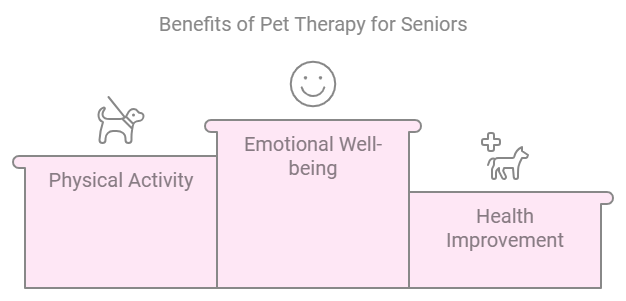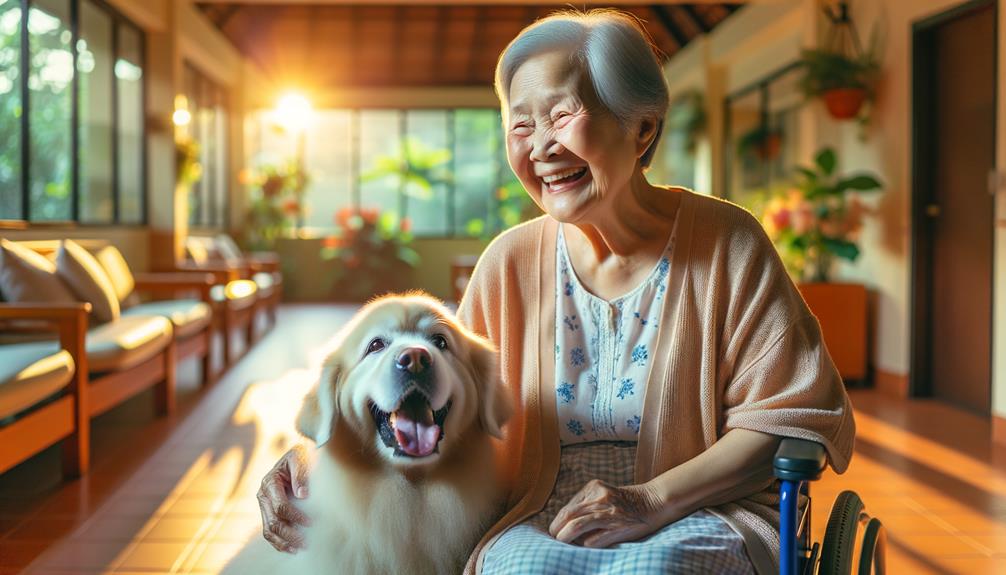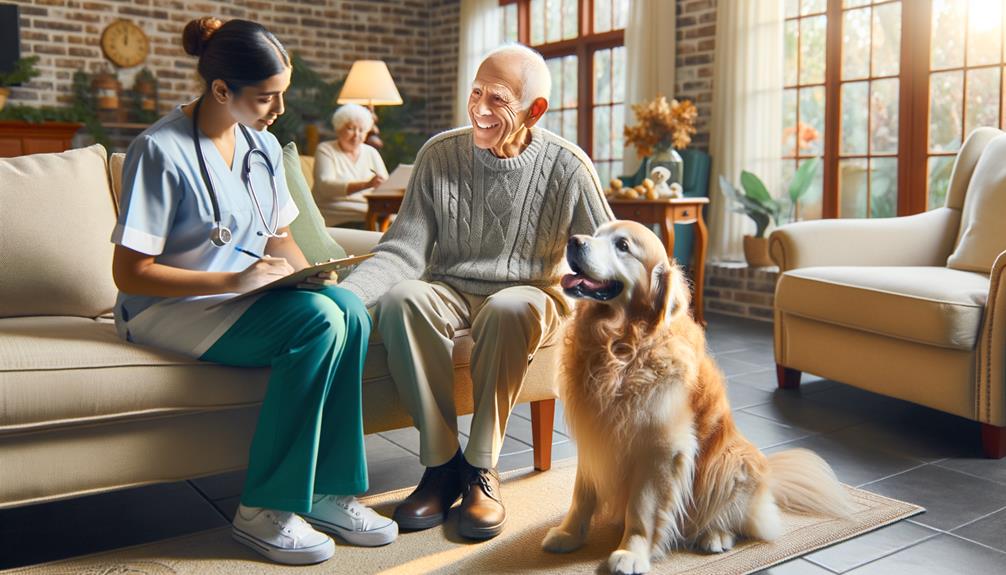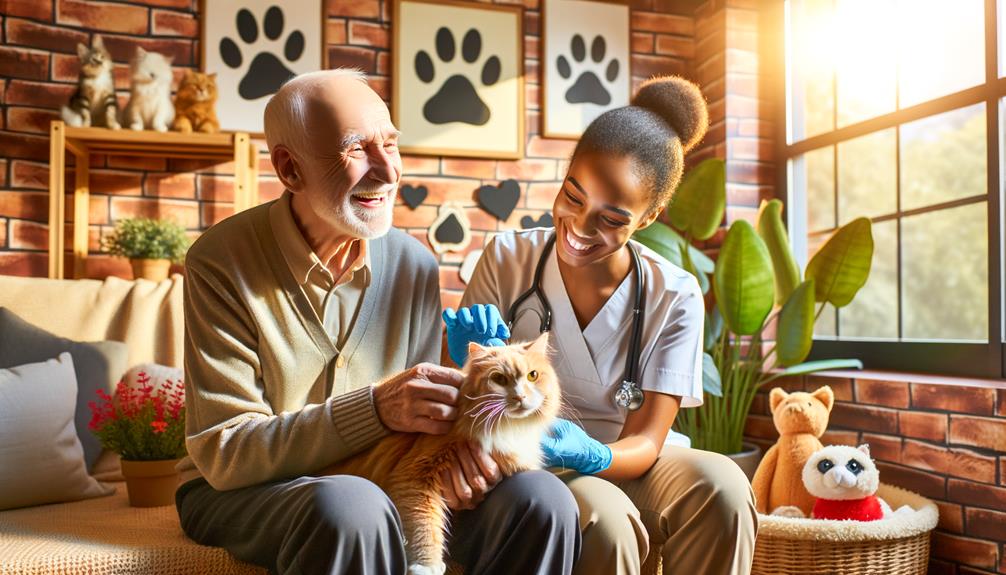Imagine Mrs. Johnson, an 85-year-old resident at our senior care facility. After the loss of her spouse, she experienced profound loneliness. However, her life transformed when she was introduced to Bella, a gentle 5-year-old Golden Retriever, through our pet therapy program. We observed a significant improvement in her mood, increased physical activity, and an overall enhancement in her health. Mrs. Johnson’s story is not unique; numerous studies have documented the positive impact of pet therapy on seniors emotionally and physically. At our facility, we’ve witnessed these benefits firsthand. But how can we effectively communicate this to potential residents and their families? How can we ensure that our pet therapy program continues to provide the highest care level? Let’s explore these questions.
To convey the compelling story of pet therapy, it’s crucial to present real-life examples like Mrs. Johnson’s experience. Highlighting the emotional and physical benefits, supported by scientific research and tangible outcomes, can effectively demonstrate the transformative impact of pet therapy. It’s about illustrating, not just stating, the difference it can make in seniors’ lives.
Ensuring the excellence of our pet therapy program begins with actively listening to our residents and understanding their needs. Continuous evaluation and adaptation of the program are essential to meeting individual preferences and providing a safe, nurturing environment for both the residents and the therapy animals involved.
Our ultimate goal is to offer the best possible care for our seniors. If pet therapy can contribute to achieving this, we must implement it thoughtfully and share its benefits widely.

Understanding Pet Therapy

Pet therapy, also known as animal-assisted therapy, involves using trained animals to provide comfort and companionship to individuals. It significantly improves seniors’ lives by offering emotional support and a range of holistic benefits. Friendly and well-trained therapy animals interact with seniors to alleviate loneliness and provide emotional comfort. The deep-seated benefits of pet therapy are well-documented and supported by research.
In our commitment to providing comprehensive care for seniors, we recognize that pet therapy can take place in various forms, such as personal pet ownership, structured visitation programs, and formal animal-assisted therapy sessions. These approaches can be tailored to meet each senior’s individual needs and circumstances, making pet therapy a flexible and effective method.
Beyond companionship, pet therapy offers tangible health benefits. Interacting with animals can stimulate mental activity and provide a sense of responsibility as seniors engage in caring for their pets. This interaction disrupts the monotony and isolation that seniors may face, infusing their lives with purpose and joy.
By understanding pet therapy, we acknowledge its role in reducing loneliness, enhancing emotional well-being, and stimulating mental engagement among seniors. As we strive to support our residents, it is essential to champion pet therapy in senior care, aiming to improve the quality of life for our cherished seniors.
Benefits of Pet Therapy for Seniors
Pet therapy can be a transformative experience for seniors. The presence of animals can significantly enhance emotional health by combating feelings of loneliness and social isolation. Interacting with pets introduces joy and a renewed enthusiasm for life, enriching their daily routines.

The benefits extend beyond emotional support. Studies have shown that pet therapy can improve physical health, such as lower blood pressure, reduced stress levels, and increased physical activity. Regular interactions with pets encourage seniors to engage in gentle exercise and mobility, which is crucial for maintaining heart health and overall physical well-being. This illustrates pet therapy’s profound impact on seniors’ health.
Moreover, pet therapy is a carefully designed approach to senior care. Research indicates it can improve memory and cognitive function, particularly in individuals with dementia or Alzheimer’s. By incorporating pet therapy into care plans, we can provide a holistic approach that addresses both the emotional and physical needs of our elderly residents. Embracing pet therapy allows us to enhance the quality of life for seniors in a compassionate and meaningful way.
Implementing Pet Therapy in Senior Care
Integrating pet therapy into senior care requires a thoughtful and strategic approach to maximize its benefits. It’s more than simply having animals present in assisted living facilities; it’s about creating meaningful interactions that enhance the health and spirits of our seniors.

Our plan to implement pet therapy includes the following steps:
- Diverse Therapy Options: Introducing various forms of pet therapy, including personal pet ownership opportunities, structured pet visitation programs, and formal animal-assisted therapy sessions.
- Variety of Animals: Expanding the range of therapy animals to include not only dogs and cats but also other suitable animals such as rabbits, birds, or even farm animals, depending on residents’ preferences.
- Personalized Sessions: Designing therapy sessions tailored to each senior’s specific needs and interests to ensure meaningful and enjoyable experiences.
- Monitoring Outcomes: Regularly track and evaluate the impact of pet therapy on seniors’ physical and emotional health to continually improve the program.
Implementing pet therapy offers numerous advantages for seniors, including stress reduction, alleviation of loneliness and depression, improved cardiovascular health, enhanced social interaction, and increased mobility. By integrating pet therapy into our care programs, we are enriching the lives of our seniors and setting a standard for excellence in senior care.
Challenges and Solutions in Pet Therapy
While pet therapy has significant benefits, potential challenges must be addressed to ensure the program’s success. Recognizing and overcoming these obstacles is crucial for providing a safe and effective pet therapy experience.

Some common challenges and their solutions include:
| Challenge | Solution | Benefit to Seniors |
|---|---|---|
| Pet Care Responsibilities | Provide Training and Support | Enhances Engagement and Confidence |
| Mobility Limitations | Offer Adaptive Activities | Improves Physical Fitness |
| Selecting Appropriate Animals | Utilize Professional Training | Ensures Safe Interactions |
When introducing pet therapy, it’s essential to consider individual allergies, phobias, or past experiences with animals. Customizing pet therapy sessions to accommodate these factors maximizes the benefits and enhances the well-being of seniors.
Additionally, maintaining open communication with residents and their families can help address concerns and tailor the program to meet their needs. By proactively managing challenges, we can provide a pet therapy program that is both safe and profoundly beneficial.
Marketing Strategies for Pet Therapy
To effectively promote our pet therapy program, we need to highlight its value and potential impact on senior care. Focusing on strategic marketing initiatives can help us reach potential residents and their families.

- Sharing Success Stories: Highlight personal anecdotes of seniors who have benefited from pet therapy, showcasing emotional benefits like companionship and joy. These narratives can be shared on our website, social media platforms, and in promotional materials.
- Collaborating with Healthcare Professionals: Partner with doctors, therapists, and senior care specialists to endorse pet therapy’s mental and physical health benefits for the elderly.
- Educational Workshops: Host webinars or workshops at senior living communities and healthcare facilities to demonstrate the positive effects of pet therapy firsthand.
- Engaging Local Media: Reach out to local newspapers, radio stations, and television networks to feature stories about the advantages of pet therapy in senior care.
- Utilizing Online Platforms: Enhance our online presence through informative blog posts, videos, and interactive content that educates and engages the audience about pet therapy.
By implementing these marketing strategies, we are not merely promoting a service but offering a meaningful solution to common challenges faced by seniors, such as health issues and social isolation. We advocate for the improved well-being of our elders and emphasize the significant difference that pet companionship can make in their lives.
Frequently Asked Questions
What are the benefits of pet therapy for older adults?
Pet therapy offers numerous benefits for older adults, including improved cardiovascular health, enhanced physical mobility, and reduced stress levels. Interacting with animals can alleviate feelings of anxiety and loneliness, promote social interaction, and provide a sense of purpose. According to a study published in the International Journal of Environmental Research and Public Health, pet therapy can significantly improve the quality of life for seniors.
How can pets help the elderly?
Pets provide companionship and emotional support, which can especially benefit the elderly. They help reduce stress, encourage physical activity, and promote social interaction. The presence of a pet can combat feelings of loneliness and depression, contributing to a healthier and more positive outlook on life.
Why is pet therapy beneficial for individuals with dementia?
Pet therapy can profoundly impact individuals with dementia. Interactions with animals can stimulate memory recall, reduce agitation, and improve mood. The Alzheimer’s Society notes that pet therapy can provide comfort and enhance the quality of life for dementia patients by offering a calming presence and engaging the senses.
What is the primary goal of animal-assisted therapy?
Animal-assisted therapy aims to improve an individual’s physical, emotional, and mental well-being. By fostering a therapeutic bond between the person and the animal, it aims to reduce feelings of isolation, provide emotional support, and enhance the overall quality of life. This therapy is tailored to meet specific therapeutic objectives, as outlined by organizations like Pet Partners.



